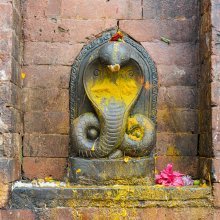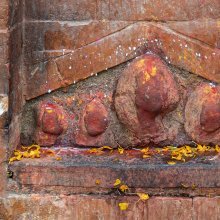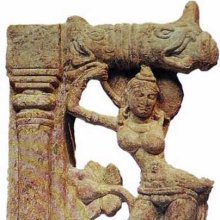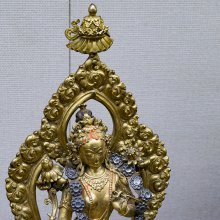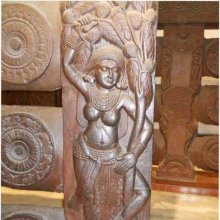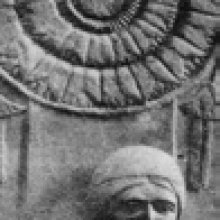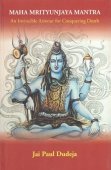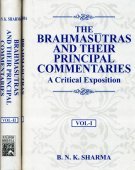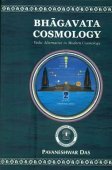Devata, Devatā, Devāṭa, Devaṭa: 25 definitions
Introduction:
Devata means something in Buddhism, Pali, Hinduism, Sanskrit, Jainism, Prakrit, Marathi, Hindi. If you want to know the exact meaning, history, etymology or English translation of this term then check out the descriptions on this page. Add your comment or reference to a book if you want to contribute to this summary article.
Images (photo gallery)
(+14 more images available)
In Hinduism
Vedanta (school of philosophy)
Source: archive.org: The Taittiriya-upanishadDevatā (देवता):—Mitra is the Devatātman,—the Shining One, the Intelligence, the Self identifying Himself with, and manifesting Himself as, day and prāṇa or upward current of life-breath. Varuṇa is the Intelligence concerned with night and apāna or downward current of life-breath, Aryaman with the eye and the sun, Indra with strength, Bṛhaspati with speech and buddhi or intellect, Viṣṇu with the feet. These and others are the Devatās working in the individual organism.
May all these Devatās be propitious to us. It is only when these are propitious to us that wisdom can be studied, retained in memory and imparted to others without any obstacle. Hence the prayer to them to be propitious. (See Taittirīya-Upaniṣad 1.1 with Śaṅkarāchārya’s commentary)

Vedanta (वेदान्त, vedānta) refers to a school of orthodox Hindu philosophy (astika), drawing its subject-matter from the Upanishads. There are a number of sub-schools of Vedanta, however all of them expound on the basic teaching of the ultimate reality (brahman) and liberation (moksha) of the individual soul (atman).
Purana and Itihasa (epic history)
Source: Cologne Digital Sanskrit Dictionaries: The Purana IndexDevata (देवत).—33 crores;1 30 crores?2 Relations of, with Sages and Pitṛs.3

The Purana (पुराण, purāṇas) refers to Sanskrit literature preserving ancient India’s vast cultural history, including historical legends, religious ceremonies, various arts and sciences. The eighteen mahapuranas total over 400,000 shlokas (metrical couplets) and date to at least several centuries BCE.
Jyotisha (astronomy and astrology)
Source: Wisdom Library: Brihat Samhita by VarahamihiraDevatā (देवता) or Devatābhakta refers to “religious men”, according to the Bṛhatsaṃhitā (chapter 15) (“On the nakṣatras—‘asterisms’”), an encyclopedic Sanskrit work written by Varāhamihira mainly focusing on the science of ancient Indian astronomy astronomy (Jyotiṣa).—Accordingly, “Those who are born on the lunar day of Uttarāṣāḍha will be chief ministers or wrestlers; will keep elephants and horses, will be religious (devatābhakta); will be men of principles; soldiers; happy and of bright appearance. Those who are born on the lunar day of Śravaṇa will be cunning, of active habits, efficient workmen, bold, virtuous, god-fearing and truthful”.

Jyotisha (ज्योतिष, jyotiṣa or jyotish) refers to ‘astronomy’ or “Vedic astrology” and represents the fifth of the six Vedangas (additional sciences to be studied along with the Vedas). Jyotisha concerns itself with the study and prediction of the movements of celestial bodies, in order to calculate the auspicious time for rituals and ceremonies.
Shaivism (Shaiva philosophy)
Source: Brill: Śaivism and the Tantric TraditionsDevatā (देवता) refers to “(all the) Gods”, according to the 9th-century Sarvajñānottaratantra chapter 18.—Accordingly, “Next, I shall teach the best observance among observances, which is known as the Śiva-vrata and which is revered by Asuras and Gods alike. [...] Next, I shall teach the characteristics of a temple of Śiva, as well as [how to perform] the installation of the liṅga, in which the universe is [itself] ‘installed’. All the gods (devatā), beginning with Brahmā, reside in the Liṅga; therefore a Yogin who venerates his guru, God and the fire and who has performed his vidyāvrata should install the liṅga, following the procedure taught in scripture. [...]”.

Shaiva (शैव, śaiva) or Shaivism (śaivism) represents a tradition of Hinduism worshiping Shiva as the supreme being. Closely related to Shaktism, Shaiva literature includes a range of scriptures, including Tantras, while the root of this tradition may be traced back to the ancient Vedas.
Yoga (school of philosophy)
Source: Brill: Śaivism and the Tantric Traditions (yoga)Devatā (देवता) refers to the “deities (of the seats)”, according to the Amṛtasiddhi, a 12th-century text belonging to the Haṭhayoga textual tradition.—Accordingly, “There are oceans, rivers, regions [and] guardians of the regions; gathering places, sacred sites, seats [of deities and] the deities of the seats (pīṭha-devatā)”.

Yoga is originally considered a branch of Hindu philosophy (astika), but both ancient and modern Yoga combine the physical, mental and spiritual. Yoga teaches various physical techniques also known as āsanas (postures), used for various purposes (eg., meditation, contemplation, relaxation).
General definition (in Hinduism)
Source: Hindupedia: The Hindu EncyclopediaDevata is a constituent of sacrifice as well as its result. Devatas consume the havis offered in a sacrifice and give the result of sacrifice performed. As a result of sacrifice, along with the desired result, the grace of devata remains. When sacrifice is performed without desiring a result, devata’s grace remains the result of sacrifice. Devata is mantra-baddha, meaning He is bound to give the result of a sacrifice/mantra when invoked. Thus the result of any form of worship is bound to come.
In Buddhism
Tibetan Buddhism (Vajrayana or tantric Buddhism)
Source: Wisdom Library: Tibetan BuddhismDevatā (देवता) refers to one of the female Śrāvakas mentioned as attending the teachings in the 6th century Mañjuśrīmūlakalpa: one of the largest Kriyā Tantras devoted to Mañjuśrī (the Bodhisattva of wisdom) representing an encyclopedia of knowledge primarily concerned with ritualistic elements in Buddhism. The teachings in this text originate from Mañjuśrī and were taught to and by Buddha Śākyamuni in the presence of a large audience (including Devatā).

Tibetan Buddhism includes schools such as Nyingma, Kadampa, Kagyu and Gelug. Their primary canon of literature is divided in two broad categories: The Kangyur, which consists of Buddha’s words, and the Tengyur, which includes commentaries from various sources. Esotericism and tantra techniques (vajrayāna) are collected indepently.
In Jainism
General definition (in Jainism)
Source: Wisdom Library: JainismDevatā (देवता, “celestial beings”) refers to “attributing faults the celestial beings” and is one of the causes leading to the influx (āsrana) of faith-deluding (darśana-mohanīya) karmas.
Devatā is a Sanskrit technical term defined in the Tattvārthasūtra (ancient authorative Jain scripture) from the 2nd century, which contains aphorisms dealing with philosophy and the nature of reality.
Source: Encyclopedia of Jainism: Tattvartha Sutra 6: Influx of karmasDevatā (देवता).—What is meant by finding faults in the celestial beings (devatā-avarṇavāda)? To call the celestial beings as eaters of meat, consumer of alcohol and enjoying sex with other women is finding faults with the gods and goddesses.

Jainism is an Indian religion of Dharma whose doctrine revolves around harmlessness (ahimsa) towards every living being. The two major branches (Digambara and Svetambara) of Jainism stimulate self-control (or, shramana, ‘self-reliance’) and spiritual development through a path of peace for the soul to progess to the ultimate goal.
Languages of India and abroad
Pali-English dictionary
Source: BuddhaSasana: Concise Pali-English Dictionarydevatā : (f.) a deity.
Source: Sutta: The Pali Text Society's Pali-English DictionaryDevatā, (f.) (deva+tā, qualitative-abstr. suffix, like Lat. juventa, senecta, Goth. hauhipa, Ohg. fullida cp. Sk. pūrṇatā, bandhutā etc.) “condition or state of a deva, ” divinity; divine being, deity, fairy. The term comprises all beings which are otherwise styled devas, & a list of them given at Nd2 308 & based on the principle that any being who is worshipped (or to whom an offering is made or a gift given: de-vatā=yesaṃ deti, as is expressed in the conclusion “ye yesaṃ dakkhiṇeyyā te tesaṃ devatā”) is a devatā, comprises 5 groups of 5 kinds each, viz. (1) ascetics; (2) domestic animals (elephants, horses, cows, cocks, crows); (3) physical forces & elements (fire, stone etc.); (4) lower gods (: bhumma devā) (nāgā, suvaṇṇā, yakkhā, asurā, gandhabbā); (5) higher gods (: inhabitants of the devaloka proper) Mahārājā, Canda, Suriya, Inda, Brahmā), to which are added the 2 aspects of the sky-god as devadevatā & disā-devatā).—Another definition at VvA.21 simply states: devatā ti devaputto pi Brahmā pi devadhītā pi vuccati.—Among the var. deities the foll. are frequently mentioned: rukkha° tree-gods or dryads M.I, 306; J.I, 221; PvA.5; vatthu° earth gods (the four kings) Pv 41; PvA.17; vana° wood-nymphs M.I, 306; samudda° water-sprites J.II, 112 etc. etc. ‹-› D.I, 180 (mahiddhikā, pl.), 192; II, 8, 87, 139, 158; S.I, sq.; IV, 302; M.I, 245; II, 37; A.I, 64, 210, 211; II, 70 (sapubba°); III, 77 (bali-paṭiggāhikā), 287 (saddhāya samannāgatā); 309; IV, 302 sq., 390 (vippaṭisāriniyo); V, 331; Sn.45, 316, 458, 995, 1043; Dh.99; J.I, 59, 72, 223, 256; IV, 17, 474; Vv 163; Pv.II, 110; KhA 113, 117; PvA.44.
— or —
Devata, (adj.) (-°) having such & such a god as one’s special divinity, worshipping, a worshipper of, devotee of Miln.234 (Brahma°+Brahma (garuka).—f. devatā in pati° “worshipping the husband, ” i.e. a devoted wife J.III, 406; VvA.128. (Page 330)

Pali is the language of the Tipiṭaka, which is the sacred canon of Theravāda Buddhism and contains much of the Buddha’s speech. Closeley related to Sanskrit, both languages are used interchangeably between religions.
Marathi-English dictionary
Source: DDSA: The Molesworth Marathi and English Dictionarydēvata (देवत).—n (Properly daivata) A god. 2 fig. A darling, fondling, tiddling, pet.
--- OR ---
dēvatā (देवता).—f (S) A god or deity. 2 Divinity, godship, divine power or essence.
Source: DDSA: The Aryabhusan school dictionary, Marathi-Englishdēvata (देवत).—n A god. A darling, fondling.
--- OR ---
dēvatā (देवता).—f A god or deity. Divinity.
Marathi is an Indo-European language having over 70 million native speakers people in (predominantly) Maharashtra India. Marathi, like many other Indo-Aryan languages, evolved from early forms of Prakrit, which itself is a subset of Sanskrit, one of the most ancient languages of the world.
Sanskrit dictionary
Source: DDSA: The practical Sanskrit-English dictionaryDevatā (देवता).—
1) Divine dignity or power, divinity; शाकल्य तस्य का देवतेत्यमृतमिति होवाच (śākalya tasya kā devatetyamṛtamiti hovāca) Bṛ. Up.3.9.1; cf. ŚB. on MS. 1.4.23;6.3.19.
2) A deity, god; Kumārasambhava 1.1.
3) The image of a deity; Manusmṛti 4.13.
4) An idol.
5) An organ of sense.
--- OR ---
Devāṭa (देवाट).—Name of a sacred place called Harihara.
Derivable forms: devāṭaḥ (देवाटः).
--- OR ---
Devaṭa (देवट).—An artisan, a mechanic.
Derivable forms: devaṭaḥ (देवटः).
Source: Cologne Digital Sanskrit Dictionaries: Edgerton Buddhist Hybrid Sanskrit DictionaryDevata (देवत).—m., nt., divinity; interpreted by Weller 36 as = Sanskrit daivata; that may have something to do with it, but see § 9.4; in part it seems also a matter of use of m. and nt. endings (and modifiers) with f. noun (devatā): kasmān name devate (acc. pl.) Lalitavistara 120.12 (verse), why should he bow to the gods?; devataiḥ 221.5 and 10 (verses; only v.l. devaiḥ, unmetrical(ly)); -devataiḥ, °tair also 281.5, 8 (verse, no v.l.); kiṃcid giridevatam vā nadīdevataṃ vā (n. sg.) 382.6 (prose; Calcutta (see LV.) daiv°); ete catvāro bodhivṛkṣade- vatās (m. n. pl.) 401.22 (prose), and tān devatān (acc. pl.) 402.2; anye…-devatāḥ 421.9 (verse), and in next line teṣāṃ, referring to these devatāḥ; in Divyāvadāna 209.5 (prose) ane- kābhir Vaiśālīvananivāsinībhir devatair (despite fem. adjs.!).
--- OR ---
Devatā (देवता) or Devatī.—(the form °tī is cited by [Ardha-Māgadhī Dictionary] from a manuscript work as = Devakī, the mother of Kṛṣṇa!), divinity: only noted in Sādhanamālā, but fairly com- mon there, by the side of devatā; devatyaḥ, °tyo Sādhanamālā 140.11; 180.10; 185.19; -tyor, loc. dual, 191.22; daśade- vatīparivṛtaṃ 195.6; sarvāsāṃ °tīnāṃ 199.4, etc.
Source: Cologne Digital Sanskrit Dictionaries: Shabda-Sagara Sanskrit-English DictionaryDevaṭa (देवट).—mfn.
(-ṭaḥ-ṭā-ṭaṃ) An artist, an artisan. E. div to sport, aṭan Unadi aff.
--- OR ---
Devatā (देवता).—f.
(-tā) 1. A god, a deity or divine being. 2. Divinity; see devatva. E. deva divine, svārthe tal affix of the abstract: in the first case, an added; of whom the attribute is divinity.
Source: Cologne Digital Sanskrit Dictionaries: Benfey Sanskrit-English DictionaryDevatā (देवता).—[deva + tā], f. The state or nature of a deity, Mahābhārata 13, 308. 2. A deity, [Mānavadharmaśāstra] 2, 176. 3. A sacred image, [Mānavadharmaśāstra] 4, 130.
Source: Cologne Digital Sanskrit Dictionaries: Cappeller Sanskrit-English DictionaryDevatā (देवता).—1. [feminine] godhead, divinity ([abstract] & concr.); a god or idol.
--- OR ---
Devatā (देवता).—2. ([instrumental] [adverb]) like a god or among the gods.
Source: Cologne Digital Sanskrit Dictionaries: Aufrecht Catalogus CatalogorumDevaṭa (देवट) as mentioned in Aufrecht’s Catalogus Catalogorum:—poet. [Subhāshitāvali by Vallabhadeva]
Source: Cologne Digital Sanskrit Dictionaries: Monier-Williams Sanskrit-English Dictionary1) Devatā (देवता):—[=deva-tā] [from deva] a See devatā.
2) Devāṭa (देवाट):—[from deva] m. Name of a sacred bathing. place, [Varāha-purāṇa] (cf. patny-āṭa).
3) Devatā (देवता):—[from deva] b f. godhead, divinity (abstr. & concr.), [Ṛg-veda; Atharva-veda; Brāhmaṇa] etc.
4) [v.s. ...] image of a deity, idol, [Manu-smṛti iv, 130; Mahābhārata; Purāṇa] (ifc. -ka, [Manvarthamuktāvalī, kullūka bhaṭṭa’s Commentary on manu-smṛti viii, 105])
5) [v.s. ...] Name of the organs of sense (cf. deva), [Śatapatha-brāhmaṇa ii, 5, 2, 2 etc.]
6) [v.s. ...] ind. with divinity id est. with a god (gods) or among the gods, [Ṛg-veda; Atharva-veda]
7) Devaṭa (देवट):—m. (√dev? [Uṇādi-sūtra iv, 81 [Scholiast or Commentator]]) artist, artisan.
Source: Cologne Digital Sanskrit Dictionaries: Yates Sanskrit-English Dictionary1) Devaṭa (देवट):—[(ṭaḥ-ṭā-ṭaṃ) a.] An artist.
2) Devatā (देवता):—(tā) 1. f. A god; divinity.
Source: DDSA: Paia-sadda-mahannavo; a comprehensive Prakrit Hindi dictionary (S)Devatā (देवता) in the Sanskrit language is related to the Prakrit word: Devayā.
[Sanskrit to German]
Sanskrit, also spelled संस्कृतम् (saṃskṛtam), is an ancient language of India commonly seen as the grandmother of the Indo-European language family (even English!). Closely allied with Prakrit and Pali, Sanskrit is more exhaustive in both grammar and terms and has the most extensive collection of literature in the world, greatly surpassing its sister-languages Greek and Latin.
Hindi dictionary
Source: DDSA: A practical Hindi-English dictionaryDevatā (देवता):—(nm) a god, deity; divine being; —[kūca kara jānā] to be dumb -founded, to be terribly nervous.
...
See also (Relevant definitions)
Partial matches: Deva, Teva, Ta.
Starts with (+99): Devata Samyutta, Devata Sutta, Devata Vagga, Devata-mudhata, Devatabadha, Devatabali, Devatabhakta, Devatabhava, Devatabhyarcana, Devatabhyarcanapara, Devatabhyarccana, Devatabhyarchana, Devatabhyarchchana, Devatacakra, Devatada, Devatadaka, Devatadarshana, Devatadhama, Devatadhipa, Devatadhyaya.
Ends with (+158): Abhishtadevata, Adevata, Adhidevata, Adhishthatridevata, Adidevata, Adityadevata, Agnidevata, Agnihotradevata, Agnyadheyadevata, Ahibradhnadevata, Ahirbudhnyadevata, Ahnikopayuktarishichandodevata, Ajadevata, Alekhyadevata, Anandadevata, Angadevata, Annadevata, Anyadevata, Apadevata, Apanadevata.
Full-text (+636): Adhidevata, Bhagadevata, Devatayatana, Ishtadevata, Yonidevata, Sthalidevata, Vasudevata, Pashudevata, Devatadhipa, Pratidevatam, Adhidevatam, Yathadevatam, Devataveshman, Ahibradhnadevata, Abhishtadevata, Ekadevata, Dasradevata, Pitridevata, Jaladevata, Bhartridevata.
Relevant text
Search found 169 books and stories containing Devata, Deva-ta, Deva-tā, Devatā, Dēvata, Dēvatā, Devāṭa, Devaṭa; (plurals include: Devatas, tas, tās, Devatās, Dēvatas, Dēvatās, Devāṭas, Devaṭas). You can also click to the full overview containing English textual excerpts. Below are direct links for the most relevant articles:
Diaspora of Bhuta (Daiva) worshipping cult—India and Indonesia (by Shilpa V. Sonawane)
Part 10 - Diwata (Indonesia) < [Chapter 4 - Inter-Disciplinary Analysis]
Part 2 - Gramyadevata < [Chapter 1 - Introduction]
Part 1 - The Bhuta Worship of Tulunadu < [Chapter 1 - Introduction]
Bhakti-rasamrta-sindhu (by Śrīla Rūpa Gosvāmī)
Verse 2.4.142 < [Part 4 - Transient Ecstatic Disturbances (vyābhicāri-bhāva)]
Verse 1.2.116 < [Part 2 - Devotional Service in Practice (sādhana-bhakti)]
Verse 2.1.129 < [Part 1 - Ecstatic Excitants (vibhāva)]
Rig Veda (translation and commentary) (by H. H. Wilson)
Patipada (by Acariya Maha Boowa Ñanasampanno)
Chapter VII - The Story Of Venerable Acharn Chob
Chapter IX - About Beings In The Realm Of Ghosts
The Devi Bhagavata Purana (by Swami Vijñanananda)
Chapter 7 - On the greatness of one faced, etc., Rudrākṣam < [Book 11]
Chapter 7 - On the Dīkṣā vidhi or on the rules of Initiation < [Book 12]
Chapter 1 - On the description of Gāyatrī < [Book 12]
Middle Chola Temples (by S. R. Balasubrahmanyam)
Mahamandapa and Mukhamandapa < [Tanjavur/Thanjavur (Rajarajesvaram temple)]
Temples in Madagadipattu < [Chapter II - Temples of Rajaraja I’s Time]
Temples in Kolar < [Chapter IV - Temples of Rajendra I’s Time]
Related products
